Contemporary Church History Quarterly
Volume 30, Number 4 (Winter 2024)
Review Article: Tim Lorentzen, Bonhoeffers Widerstand im Gedächtnis der Nachwelt. (Paderborn: Brill Schöningh, 2023). Illustrations. ISBN 978-3-506-70473-3.
By Victoria J. Barnett, General Editor, Dietrich Bonhoeffer Works English edition, and former director, Programs on Ethics, Religion, and the Holocaust, U. S. Holocaust Memorial Museum.[i]
This fall a new film about the German theologian/resistance figure Dietrich Bonhoeffer has revived debates among Christians about his legacy and its relevance for contemporary issues. The film, Bonhoeffer: Pastor. Spy. Assassin, provoked protests (in which I was involved) from German and North American scholars in the Bonhoeffer Society and eighty-six members of the extended Bonhoeffer family, as well as disclaimers about the film’s marketing by the German actors and the film’s director. Like most films on Bonhoeffer, the new production plays fast and loose with the historical facts. Readers of this journal will be surprised, for example, to see Martin Niemoeller preaching a rousing sermon in defense of German Jews after Kristallnacht and Winston Churchill appreciatively reading excerpts from Bonhoeffer’s 1933 essay, “The Church and the Jewish Question.” Most protests focused on the film’s portrayal of Bonhoeffer’s resistance as a militant embrace of violence in the name of a just cause: a stunning misrepresentation of Bonhoeffer’s theology and, at a time of rising political violence and Christian Nationalism in the United States, a potentially dangerous one.
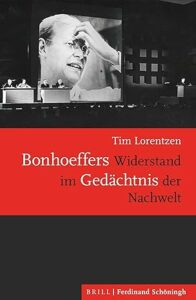 But as Tim Lorentzen’s new book illustrates, it is hardly the first time that interpretations of Bonhoeffer have been based on his ties to the German resistance. Lorentzen, Professor of Early Modern Church History at Kiel University, traces the chronology of German cultural narratives about Bonhoeffer’s resistance, and their intersections with German Protestant memorialization, from 1945 to 2006. His focus on resistance (rather than German historiography about Nazism, the Holocaust, the Protestant Kirchenkampf, or Bonhoeffer’s theological writings) is a narrow lens through which to understand Bonhoeffer, but it raises interesting and provocative questions. As historians know, Bonhoeffer was a minor figure in the resistance circles—and yet this very aspect of his life has become central in the narratives about him. Would Bonhoeffer’s theology be as well-known and widely read today if this were not the case? Has the emphasis on resistance led to the historical distortions one finds in many works on Bonhoeffer? Conversely, does it offer insights we might not otherwise have into his theology and his life?
But as Tim Lorentzen’s new book illustrates, it is hardly the first time that interpretations of Bonhoeffer have been based on his ties to the German resistance. Lorentzen, Professor of Early Modern Church History at Kiel University, traces the chronology of German cultural narratives about Bonhoeffer’s resistance, and their intersections with German Protestant memorialization, from 1945 to 2006. His focus on resistance (rather than German historiography about Nazism, the Holocaust, the Protestant Kirchenkampf, or Bonhoeffer’s theological writings) is a narrow lens through which to understand Bonhoeffer, but it raises interesting and provocative questions. As historians know, Bonhoeffer was a minor figure in the resistance circles—and yet this very aspect of his life has become central in the narratives about him. Would Bonhoeffer’s theology be as well-known and widely read today if this were not the case? Has the emphasis on resistance led to the historical distortions one finds in many works on Bonhoeffer? Conversely, does it offer insights we might not otherwise have into his theology and his life?
In his introduction, Lorentzen argues that despite the growing body of scholarship on memorialization and memory cultures (especially with respect to the history of Nazi Germany and the Holocaust), there has not yet been a work focusing on church memory culture, where Bonhoeffer has achieved unusually central and symbolic status (and not just in Germany). This is especially important between 1948 and 1989, when parallel memory cultures about the Nazi era emerged in the German Democratic Republic in the east and the Federal Republic in the west.
The process began even before all the family members had received confirmation of his death and the deaths of his brother Klaus and two brothers-in-law. In May 1945, the ecumenical press office in Geneva issued a press release about his death. The report was sent to Reinhold Niebuhr in the United States, and on June 15 Niebuhr’s tribute, “The Death of a Martyr,” was published in the U.S. biweekly magazine Christianity and Crisis. In July 1945 Bishop George Bell presided over a memorial service in London’s Holy Trinity Church, broadcast by the BBC, in which he praised Bonhoeffer and the other executed resistance figures as examples of “the other Germany” that he had championed throughout the war. One week later, Confessing Church veterans held their first postwar synod in Spandau, where Probst Hans Böhm expressed his hope that Bell’s service in London could renew the bond between British and German churches; Bonhoeffer was similarly honored at the Treysa synod in August 1945. In early October, George Bell published an account of his last conversation with Bonhoeffer in Sigtuna, Sweden, in May 1942, when Bonhoeffer had told him that God would punish Germany for its guilt and that resistance was “an act of repentance.” Weeks later in Stuttgart, German church leaders met with ecumenical leaders, including Willem Visser ‘t Hooft (who was familiar with Bell’s article), and wrote the Stuttgart Declaration of Guilt. Lorentzen argues that Bell’s account influenced the wording of the Stuttgart Declaration in October 1945. That same month, George Bell visited Germany and met with Eberhard Bethge, who had compiled excerpts of various Bonhoeffer texts. In December 1945, the World Council of Churches published these texts in a short paperback titled Zeugnis eines Boten.
By the end of 1945, then, Bonhoeffer was recognized internationally as both Christian martyr and political resister. His story had become a cornerstone of the revived relationship between the German Protestant churches and their international partners, but this meant something very different on either side of the border. Inside Germany, tensions were already developing between Bonhoeffer’s closest allies and the official postwar church. Bethge in particular viewed Bonhoeffer’s resistance and death as an implicit accusation against those who had collaborated and compromised. In contrast, some postwar German church leaders found it a useful alibi as they reconstituted the Protestant Church and navigated their relationship with the Allied occupation government. They embraced Bonhoeffer’s martyrdom and resistance as exemplary of the Protestant Church’s courage under the Nazi regime (a deceptive move that obscured the complicity of the churches and, in many cases, their own).
As Lorentzen astutely observes, the memorialization of Bonhoeffer was a public process from the very beginning of the postwar era: “there was not a single moment when it was confined to being a family affair.” [13] This is worth pondering in terms of what it meant for Eberhard Bethge, who in the summer of 1945 was helping a traumatized family that had just lost four family members to Nazi violence and assisting the survivors of several other resistance families. In his Bonhoeffer biography and elsewhere, Bethge later contended that Bonhoeffer’s significance was quickly marginalized in the postwar Protestant Church and that he was dismissed by figures like Bishop Meiser as a “political” martyr, not a religious one. Lorentzen makes a convincing case that this was untrue (and one of the features of this book is that he pushes back against Bethge’s version of some things)—although, I would add, Lorentzen’s narrow focus omits a closer look at the broader early postwar disputes among Protestants who had been involved in the Kirchenkampf (which was the background for many of Bethge’s battles).
In any case, Bethge was central to the elevation of Bonhoeffer’s story. In spring 1946 he published some of Bonhoeffer’s poetry in Unterwegs, an occasional publication by Bonhoeffer’s former students; the poems also appeared in other publications, including the international newsletter of the Fellowship of Reconciliation. Each publication put a different spin on the texts—the Berlin newspaper Neue Zeit published the poem “Night Voices in Tegel,” for example, without mentioning that Bonhoeffer was a theologian. In February 1946, on the 40th anniversary of Bonhoeffer’s birth, Bethge published an article in Neue Zeit, George Bell wrote a two-part article on the German resistance for the New York Herald Tribune, and Reinhold Niebuhr published a piece in the Union Seminary Quarterly Review about Bonhoeffer’s resistance. Bonhoeffer’s martyrdom was now firmly interwoven into German Protestant postwar ties to foreign churches, and there was international fascination with his story.
All of this influenced early perspectives on the Kirchenkampf and the German resistance. Lorentzen argues that many theologians and church leaders already understood the broader German resistance in the context of Bonhoeffer (not the other way around), leading to an early “sanctification” of the July 20 conspirators and an emphasis on Christian resistance against Nazism. This was also possible, I would add, because in the 1930s much of the international reaction to the Kirchenkampf had focused on the “Nazi persecution of Christians.” Martin Niemoeller’s trial and imprisonment became an international cause célèbre (in December 1940, Time Magazine put him on the cover as the “Martyr of 1940”). Although Lorentzen doesn’t delve into those precedents, his analysis helps to explain how the Bonhoeffer legacy dovetailed with early postwar portrayals of Confessing Church heroism. In his lectures and essays in the late 1940s, Bethge offered a similar framing of the resistance. In 1951 the first German edition of the prison letters, Widerstand und Ergebung, was published (the English publication of Letters and Papers appeared in 1953).
By then, Bonhoeffer’s status as a martyr was well established. A new phase began in which his legacy was incorporated into other postwar political narratives in the new German Federal Republic. There were two major processes between 1946 and 1961 (which Lorentzen describes as the “martyrization” phase). First, Bonhoeffer’s status as “martyr” and resistance figure gave him a broader political symbolic value. Secondly, however, postwar Germany was already moving on to the burning political issues of the 1950s. Church and civil commemorations of events like the July 20 bomb plot continued, but surviving figures from the Kirchenkampf—people like Martin Niemoeller, Otto Dibelius, Eugen Gerstenmaier, and Theodor Heckel—were now focused on issues like the Cold War and German rearmament. Gerstenmaier and Heckel (former nemeses of Bonhoeffer with whom Bethge continued to do battle) had moved into the political sphere.
The first histories of the Kirchenkampf were also written during this period; Wilhelm Niemoeller’s Die Evangelische Kirche im Dritten Reich appeared in 1956. Survivors of the July 20 circles and other groups that had been persecuted and imprisoned under the Nazi regime founded their own organizations and began holding their own commemorations. Bethge was increasingly uncomfortable with Bonhoeffer’s inclusion in the celebration of “Heldentod” (the deaths of heroes). In 1960 a two-volume set titled Das Gewissen Steht Auf and Das Gewissen Entscheidet was published (the second volume had a foreword by Willy Brandt). The books profiled individual resistance figures from the July 20 group, the Protestant and Catholic churches, all the executed members of the Bonhoeffer family, and many other resisters.
Certain events (notably the mid-1950s trials of Walter Huppenkothen, who had overseen the trials and executions of Bonhoeffer, Canaris, and other conspirators in Flossenbürg) brought Bonhoeffer’s name back into the public eye, revealing ongoing postwar divisions about the resistance. Public reaction to these trials showed that Germans were still divided in their opinions about the July 20 group, with almost half of those polled (as well as some still-some prominent apologists for the Nazi regime) condemning the conspirators as “traitors.” Huppenkothen and his co-defendants were eventually sentenced to the time they had already served in prison.
But here, Lorentzen argues, public statements from Bonhoeffer’s sole surviving brother Karl-Friedrich, survivors of the conspiracy, and Protestant theologians altered public discussion of the trials and led to a “lasting shift” in how Germans thought about the resistance. The theological memorandum and testimony from former Confessing pastor and theologian Han Joachim Iwand, in which he explained the theological foundation for resistance and even declared that the churches should have resisted in 1933, had a profound impact that extended beyond the trial. (I should add, however, that these battles continued for several decades. In 1976 Eberhard Bethge and Gerhard Leibholz won a defamation suit against a right-wing propagandist on behalf of the Bonhoeffer family).
Although Lorentzen doesn’t mention it, the Huppenkothen trial had another impact on postwar politics and international relations. A 38-minute excerpt from the trial was filmed and distributed by the West German Government Office of Political Education (the USHMM in Washington, DC, has a copy). The film clip (which opens with photographs of Bonhoeffer, Oster, Dohnanyi, and Canaris) was produced at the very moment when the Adenauer government sought to reestablish the West German military. By honoring the German conspirators who died for their resistance to National Socialism (especially Oster and Canaris, who had been leading military figures) and showing a public democratic trial of former Nazis, the clip was intended in part, I suspect, to reassure western allies at a time when German rearmament was still controversial.
It was still the era of Bonhoeffer’s “martyrization”, but his story was now firmly embedded in the historical complexities of the post-Nazi era. Perhaps not coincidentally, this was the period during which Eberhard Bethge left Germany to serve a church in London in 1953 and then came to Harvard in 1957 to begin writing the biography, where he famously observed how in the United States, ”Everyone here has his own Bonhoeffer.” In the United States, too, Bonhoeffer was already well-known as a martyr, and over the ensuring decades (to the present moment, I would argue) there are multiple and very different American spins on that story.
In 1961, the Berlin Wall was built. Divided Germany became ground zero for many international political battles. Lorentzen describes the years between 1961 and 1989 (when the Berlin Wall came down) as the era of the “politicization” of Bonhoeffer’s memory. He continued to play a morally symbolic role for German Protestants on both sides of the border, but increasingly on behalf of very different political causes. During the same years, the first postwar generation of Germans reached adulthood and began to critically challenge early hagiographies. There was a growing focus on the Nazi persecution of the Jews and the churches’ complicity with the Nazi regime. Rolf Hochuth’s critical play, Der Stellvertreter, about the role of Pope Pius XII during the Holocaust, premiered in 1963. It was also during this period that Wolfgang Gerlach wrote his And the Witnesses Were Silent: The Confessing Church and the Jews (although it was not published in Germany until 1987).
Bonhoeffer acquired a new symbolic status as a politically critical theologian who was embraced by younger theologians. His resistance against Nazism represented a critique of church leaders who had made compromises with the Deutsche Christen and the Nazis. It also offered the basis for postwar activism on other issues: his pacifism, for example, became a rallying cry for anti-nuclear groups. His postwar relevance was amplified by the 1967 publication of Bethge’s massive Bonhoeffer biography (an abridged English translation was published in 1970). Bethge’s narrative encompassed the story of the German churches and the Kirchenkampf, the role played by theologians like Karl Barth, and the German resistance, but with Bonhoeffer at the heart of every story. The biography was also Bethge’s first systematic attempt to explain Bonhoeffer’s theological journey, especially his vision for the future of the Protestant Church.
This intersected with a growing number of international church conversations in the 1960s, 1970s, and 1980s. In the German Democratic Republic, the head of the Protestant Church was Albrecht Schönherr, who had been one of Bonhoeffer’s seminarians in Finkenwalde. Schönherr took Bonhoeffer’s understanding of “the church for others” as the model for what he wanted the “church in socialism” to be. During this same period, the international Bonhoeffer Society was founded, bringing together theologians and clergy from around the world. Its first meeting was in 1976 in Geneva, underscoring Bonhoeffer’s role (and ongoing relevance) in the ecumenical movement. Bonhoeffer’s story had become seminal to Christian memory culture on a global scale, from South Africa to the United State to Asia. His theology and his life story resonated in very different churches and political circumstances.
Bethge was a singular and influential force in these developments, internationally and increasingly in terms of the publication of Bonhoeffer’s writings . During this period the German publication of the seventeen-volume Bonhoeffer Werke began, with Bethge’s involvement. He was also influential in the German church, where he often invoked Bonhoeffer’s legacy. From 1961 to 1975 he was director of the Pastoral College in the Rhineland, and in 1981 he was instrumental in shaping the Rhineland Synod’s declaration on Christian-Jewish relations, making the Rhineland church the first German Landeskirche to acknowledge the validity of Judaism.
“Politicization” is too narrow a term for some of this, but Lorentzen skillfully illustrates how Bonhoeffer’s memory remained central in shaping the German churches’ public positions during this period. During these years (especially in the 1980s, after the nationwide television broadcast of the American docudrama Holocaust), numerous localized memorials and exhibitions about the Nazi persecution of the Jews began to appear. There were also new memorials to Bonhoeffer, and hundreds of churches, schools, and streets were named after him. One of the most striking examples of this “politicization” is the Bonhoeffer statue in an outside corner of the Petrikirche in Hamburg, at the site of a protest against atomic weapons by a Tübingen teacher, Hartmut Gründler, who burned himself to death there in 1977. The site soon became a shrine for environmental activists, who covered it with flowers and marked it with a series of memorial plaques intended both to honor Gründler as well as to inspire others to protest. The ongoing protests and demonstrations inspired a deep debate within the church and in the wider public. This ended when Axel Springer, the conservative publisher of Germany’s largest tabloid, gave the money for a Bonhoeffer statue on that very spot. There it stands to the present day: an ironic “memorial” that is simultaneously an erasure (there are two images of the statue in the book’s appendix of illustrations).
It is a useful reminder that memorial culture invariably elevates certain themes and obscures others. Drawing on German bishop Wolfgang Huber’s description of Bonhoeffer as a “Protestant saint,” Lorentzen describes the third phase, from 1990-2006, as a period of “sanctification.” There were a growing number of pilgrimages, especially from other countries, to Flossenbürg, Finkenwalde, the resistance memorial sites in Berlin, and of course the Bonhoeffer Haus (where the family had lived) in Charlottenburg. Bonhoeffer’s writings and history were regularly invoked by churches and in the ecumenical movement. Even Catholic countries and shrines have honored Bonhoeffer alongside Catholic victims of Nazism like Alfred Delp and Bernard Lichtenberg. In the appendix of illustrations, Lorentzen includes photographs of many memorials to Bonhoeffer, including some there were unfamiliar to me. The most famous memorial of course is the statues of ten “modern martyrs” at the West Entrance to Westminster Abbey, unveiled in 1998. There, Bonhoeffer stands alongside figures from around the world, including Maximilian Kolbe, Martin Luther King, Jr., and Oscar Romero. But there is also an icon in the Church of San Bartolomeo in Rome (where Bonhoeffer is pictured with Catholic Bishop of Münster Clemens Graf von Galen, Bernard Lichtenberg, and Friedrich Weissler), and the Romanian Orthodox Cathedral in Nuremberg, which features Bonhoeffer together with Catholic and Protestant saints through the centuries.
The final chapter explores the significance of “Christian resistance” in church memorial culture and the inherent tensions between religious and cultural interpretations of memory. In many ways, memorialization “domesticates” resistance figures; the Petrikirche memorial statue is certainly a striking example of that. Bonhoeffer is an interesting figure in this regard because he continues to be claimed by very different kinds of Christian groups (especially in the United States). It is almost as if the status of “resister” has lifted him above theological and political divisions that might otherwise prevent people from claiming him. In the process, what scholar Stephen Haynes once called the “Bonhoeffer Phenomenon,”[ii] leads to misinterpretations of his theological writings and his historical role.
Lorentzen’s book masterfully illustrates the process by which Bonhoeffer acquired an “über-historical” status soon after the war. To this day, many books and films about him are symbolic and very selective histories of heroism and martyrdom, not actual studies of the man and his times. Not surprisingly, this also means that they are riddled with false historical claims, not just with respect to the resistance but in terms of his significance in the Kirchenkampf. Lorentzen’s book helps us understand how this happened. For that reason alone, the book is a major achievement that any student or scholar of Bonhoeffer who is writing reception history or looking at Bonhoeffer’s impact in postwar Germany should read. By focusing specifically on the issue of resistance, this book offers a fascinating analysis of how, in east and west, postwar Germany wrestled with the intersections of resistance and martyrdom over six decades. It also offers some new insights into the theological literature on Bonhoeffer, much of which has been shaped by legends of his centrality in the resistance.
At the same time, however, this work parallels (but does not discuss at any length) the changes in historical narratives about the German Kirchenkampf, the German scholarship on Nazi Germany and the Holocaust, the different phases of political memorialization and commemoration and specific debates around the Historikerstreit, and the more critical studies of the Wehrmacht and resistance circles. It would naturally be impossible to include all these other influences on the Bonhoeffer narrative and still have a coherent book, but this does skew his account of some developments.
There is one issue in particular that I wish he had addressed in greater depth: how German political and church memory cultures in these postwar decades addressed the Nazi persecution of the Jews and the Holocaust. I suspect this is partly because this remains a significant gap in the Bonhoeffer literature—which tells us something about the symbolic and ahistorical nature of many books on him. But over the decades there was growing discussion of the Holocaust in the German churches, in the various Kirchentags, and among theologians like Dorothee Soelle—and it certainly became central to the public discourse after 1979. I was surprised, for example, that he didn’t discuss Tetyana Pavlush’s 2015 Kirche nach Auschwitz zwischen Theologie und Vergangenheitspolitik,[iii] which traces these discussions in both Germanys (and she includes some analysis of Bonhoeffer’s impact).
Nonetheless, Lorentzen’s book stands on its own merits. This is an important work that led me to rethink some of my own assumptions. While not about reception history per se, it is a masterful study of the myriad political influences that shape the construction and revision of biographical and theological narratives over time. Along the way, Lorentzen offers some fascinating glimpses into the postwar telling of the Bonhoeffer story in Germany.
Notes:
[i] The views expressed in this essay are the author’s own.
[ii] Haynes, The Bonhoeffer Phenomenon: Portraits of a Protestant Saint (2004); Lorentzen mentions Haynes’ work (including his other The Bonhoeffer Legacy: Post-Holocaust Perspectives (2006).
[iii] Reviewed in this journal in 2016: https://contemporarychurchhistory.org/2016/06/review-of-tetyana-pavlush-kirche-nach-auschwitz-zwischen-theologie-und-vergangenheitspolitik/
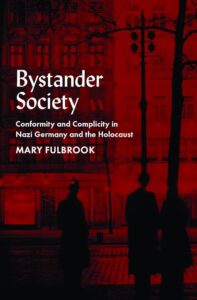 Mary Fulbrook is Professor of German History at University College London. She is a familiar and respected contributor to scholarship on Nazi Germany and the Holocaust. In this work she avoids teleological interpretations of events and rejects simplistic categorizations. She endeavors to tell the story of German bystanders “from the inside out” through “selected accounts of personal experiences” (16). She tells the stories of individuals. In so doing, she humanizes history. Victims and bystanders had names. They had stories. They were not a grouping of data points on a chart. Fulbrook’s subjects are profoundly human, and their complex stories challenge facile characterizations of society in Nazi Germany. Fulbrook’s primary sources for Part I are autobiographical essays from 1939 written on the theme “My life in Germany before and after January 30, 1933.” These essays give a broad range of everyday experiences before such memories were shaped by knowledge of the horrors of the Holocaust. Likewise, in Part II she employs a variety of firsthand accounts and memoirs to tell stories from the ground level. Fulbrook argues well for the value and limitations of her source base in her introduction.
Mary Fulbrook is Professor of German History at University College London. She is a familiar and respected contributor to scholarship on Nazi Germany and the Holocaust. In this work she avoids teleological interpretations of events and rejects simplistic categorizations. She endeavors to tell the story of German bystanders “from the inside out” through “selected accounts of personal experiences” (16). She tells the stories of individuals. In so doing, she humanizes history. Victims and bystanders had names. They had stories. They were not a grouping of data points on a chart. Fulbrook’s subjects are profoundly human, and their complex stories challenge facile characterizations of society in Nazi Germany. Fulbrook’s primary sources for Part I are autobiographical essays from 1939 written on the theme “My life in Germany before and after January 30, 1933.” These essays give a broad range of everyday experiences before such memories were shaped by knowledge of the horrors of the Holocaust. Likewise, in Part II she employs a variety of firsthand accounts and memoirs to tell stories from the ground level. Fulbrook argues well for the value and limitations of her source base in her introduction.
 The primary argument of the book is that conservative student activists, and especially leaders of the Ring Christlich-Demokratischer Studenten (Association of Christian Democratic Students or RCDS), were not only present during the 68er generation’s protests but were meaningful actors that shaped many of the era’s signature events. The photographs and opening anecdotes to each chapter alone convincingly prove this point. The cover photo shows a famous debate in Freiburg between the older liberal academic Ralf Dahrendorf and young Sozialistischer Deutscher Studentbund (SDS) figurehead Rudi Dutschke. Lurking in the margins of the photo are young Christian Democrats, Meinhard Ade and Ignaz Bender, who helped organize the event and participated in the debate. Von der Goltz emphasizes how these two students are rarely recognized and sometimes even cropped out of this famous photo to illustrate how the primary subjects of her inquiry have been overlooked. The presence of Ade and Bender at the debate is nonetheless significant. On the one hand, they positioned themselves against their generational spokesperson, Dutschke, and spoke out against left-wing radicalism. On the other hand, their willingness to dialogue with left-wing students and their embrace of the liberal Dahrendorf distinguished them from the older generations of Christian Democrats. Another chapter opens by revealing that the RCDS had organized the visit of the South Vietnamese ambassador in 1966, which Rudi Dutschke and the SDS interrupted, to intentionally draw national attention to the New Left’s unpopular protest tactics. Additionally, the fifth chapter opens with a description of when RCDS chair Gerd Langguth held his ground, condemning the constitutional threat posed by the Marxist Student Association Spartakus while being pelted by cheese curds in 1972. Such examples highlight the often-forgotten role of the right in these moments of protest and illustrates how young Christan Democrats initiated dialogue about reform in the 1960s, imitated many of the theatrical tactics of their left-wing adversaries, and eventually condemned the far-left’s militant turn in the 1970s.
The primary argument of the book is that conservative student activists, and especially leaders of the Ring Christlich-Demokratischer Studenten (Association of Christian Democratic Students or RCDS), were not only present during the 68er generation’s protests but were meaningful actors that shaped many of the era’s signature events. The photographs and opening anecdotes to each chapter alone convincingly prove this point. The cover photo shows a famous debate in Freiburg between the older liberal academic Ralf Dahrendorf and young Sozialistischer Deutscher Studentbund (SDS) figurehead Rudi Dutschke. Lurking in the margins of the photo are young Christian Democrats, Meinhard Ade and Ignaz Bender, who helped organize the event and participated in the debate. Von der Goltz emphasizes how these two students are rarely recognized and sometimes even cropped out of this famous photo to illustrate how the primary subjects of her inquiry have been overlooked. The presence of Ade and Bender at the debate is nonetheless significant. On the one hand, they positioned themselves against their generational spokesperson, Dutschke, and spoke out against left-wing radicalism. On the other hand, their willingness to dialogue with left-wing students and their embrace of the liberal Dahrendorf distinguished them from the older generations of Christian Democrats. Another chapter opens by revealing that the RCDS had organized the visit of the South Vietnamese ambassador in 1966, which Rudi Dutschke and the SDS interrupted, to intentionally draw national attention to the New Left’s unpopular protest tactics. Additionally, the fifth chapter opens with a description of when RCDS chair Gerd Langguth held his ground, condemning the constitutional threat posed by the Marxist Student Association Spartakus while being pelted by cheese curds in 1972. Such examples highlight the often-forgotten role of the right in these moments of protest and illustrates how young Christan Democrats initiated dialogue about reform in the 1960s, imitated many of the theatrical tactics of their left-wing adversaries, and eventually condemned the far-left’s militant turn in the 1970s. Based on her 2017 dissertation in Protestant theology at the Ludwig-Maximilians-University, Loos presents a meticulously researched, insightful, and densely written work on German Protestant attitudes toward communism in general (ideas, ideologies, organizations) and Soviet communist-Bolshevism in particular. Occasionally referencing pre-World War I events, her focus is Germany’s political transition through the Weimar Republic into the Third Reich, tracing the intensification of anti-communist rhetoric on the eve of World War II and the eventual military assault on the Soviet Union in 1941. While the opening chapter points to a few academic-theological debates at the turn of the century on possible family resemblances between the ideals of early Christian and communist communities, the last chapter briefly outlines post-war developments in the Protestant churches until the mid-1950s, with anti-communist stances, though more restrained, remaining largely intact.
Based on her 2017 dissertation in Protestant theology at the Ludwig-Maximilians-University, Loos presents a meticulously researched, insightful, and densely written work on German Protestant attitudes toward communism in general (ideas, ideologies, organizations) and Soviet communist-Bolshevism in particular. Occasionally referencing pre-World War I events, her focus is Germany’s political transition through the Weimar Republic into the Third Reich, tracing the intensification of anti-communist rhetoric on the eve of World War II and the eventual military assault on the Soviet Union in 1941. While the opening chapter points to a few academic-theological debates at the turn of the century on possible family resemblances between the ideals of early Christian and communist communities, the last chapter briefly outlines post-war developments in the Protestant churches until the mid-1950s, with anti-communist stances, though more restrained, remaining largely intact.
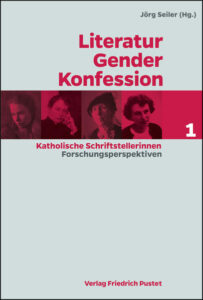 The study on Catholic women authors was funded by the Deutsche Forschungsgemeinschaft and based at the University of Erfurt. Antonia Leugers, Jörg Seiler, and Lucia Scherzberg, well-known historians of German Catholicism, as well as other church historians and several literature scholars and experts in database-supported research, collaborated on this study. Establishing a database of 160 Catholic women authors, as many as the grant permitted, the participants welcome future scholars to append additional writers, especially from earlier and later periods, to the historical record.
The study on Catholic women authors was funded by the Deutsche Forschungsgemeinschaft and based at the University of Erfurt. Antonia Leugers, Jörg Seiler, and Lucia Scherzberg, well-known historians of German Catholicism, as well as other church historians and several literature scholars and experts in database-supported research, collaborated on this study. Establishing a database of 160 Catholic women authors, as many as the grant permitted, the participants welcome future scholars to append additional writers, especially from earlier and later periods, to the historical record.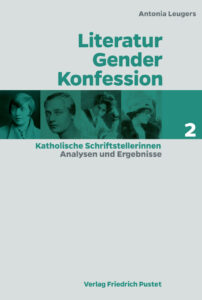 Instead, the volumes offer a wealth of case studies. Some of the authors, such as Gertrud von le Fort and Hedwig Dransfeld, were well-known, while others published only a few works. Each of the authors has their history. The Leugers volume includes a primarily quantitative summary of the women’s experiences, how many got divorced, converted to Catholicism, left the church, lived in same-sex relationships, had children out of wedlock, attempted suicide, chose cremation, were childless, etc. Leugers admits, however, that such personal information is sometimes difficult to obtain and that, given the limited sample, the data are more “symptomatic” than representative. This detailed qualitative analysis, however, lacks explanatory power. The more important questions raised in the project remain unanswered. The authors offer no conclusions about Catholic women’s emancipation, their understanding of gender, chastity, and parenthood. While some suggest disapproval of modernity, most suggest ways of accommodating it while maintaining a life of faith. In all cases, Catholic faith triumphs. Beyond this, however, this rich body of evidence cries for additional meaningful analysis. One wonders if these volumes report results from which results can be drawn.
Instead, the volumes offer a wealth of case studies. Some of the authors, such as Gertrud von le Fort and Hedwig Dransfeld, were well-known, while others published only a few works. Each of the authors has their history. The Leugers volume includes a primarily quantitative summary of the women’s experiences, how many got divorced, converted to Catholicism, left the church, lived in same-sex relationships, had children out of wedlock, attempted suicide, chose cremation, were childless, etc. Leugers admits, however, that such personal information is sometimes difficult to obtain and that, given the limited sample, the data are more “symptomatic” than representative. This detailed qualitative analysis, however, lacks explanatory power. The more important questions raised in the project remain unanswered. The authors offer no conclusions about Catholic women’s emancipation, their understanding of gender, chastity, and parenthood. While some suggest disapproval of modernity, most suggest ways of accommodating it while maintaining a life of faith. In all cases, Catholic faith triumphs. Beyond this, however, this rich body of evidence cries for additional meaningful analysis. One wonders if these volumes report results from which results can be drawn. Another instance in which women’s agency proved important can be found in Dominik Schindler’s discussion of the relationship between the Katholische Deutsche Frauenbund and Michael von Faulhaber, a theology professor at Strasbourg and bishop of Speyer. In a nuanced brief essay, Schindler argues that Faulhaber actively supported the formation of the Frauenbund and the Hildburgisbund, an organization supporting female university students. According to Schindler, Faulhaber largely adhered to traditional values, but insisted that Catholic values reflect the equal role many Catholic women played in securing the family’s income. He also argued publicly that Catholic theology proved no obstacle to women’s suffrage. While men remained heads of household, this did not consign women to second-class status. Faulhaber’s view of the family remained conservative. Still, he acknowledged that in an industrial society, a man’s wages might not suffice to meet the family’s expenses, and thus a woman might be forced to work. Faulhaber argued that women from the upper classes should be encouraged to participate in social and cultural life. In contrast, women in the lower classes deserved much support to earn an honorable living. He believed that women’s work was necessary to meet the needs of their children. Schindler argues that, even if Faulhaber’s views seem backward today, at the time, they were quite progressive.
Another instance in which women’s agency proved important can be found in Dominik Schindler’s discussion of the relationship between the Katholische Deutsche Frauenbund and Michael von Faulhaber, a theology professor at Strasbourg and bishop of Speyer. In a nuanced brief essay, Schindler argues that Faulhaber actively supported the formation of the Frauenbund and the Hildburgisbund, an organization supporting female university students. According to Schindler, Faulhaber largely adhered to traditional values, but insisted that Catholic values reflect the equal role many Catholic women played in securing the family’s income. He also argued publicly that Catholic theology proved no obstacle to women’s suffrage. While men remained heads of household, this did not consign women to second-class status. Faulhaber’s view of the family remained conservative. Still, he acknowledged that in an industrial society, a man’s wages might not suffice to meet the family’s expenses, and thus a woman might be forced to work. Faulhaber argued that women from the upper classes should be encouraged to participate in social and cultural life. In contrast, women in the lower classes deserved much support to earn an honorable living. He believed that women’s work was necessary to meet the needs of their children. Schindler argues that, even if Faulhaber’s views seem backward today, at the time, they were quite progressive.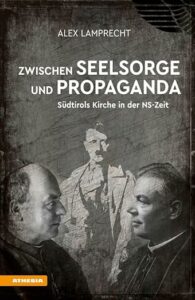 Under the terms of the Hitler-Mussolini Agreement, all those South Tyroleans who retained Austrian citizenship after 1919 were now considered citizens of the Reich. They had no choice but to resettle in post-Anschluss Germany. South Tyroleans who had become Italians in 1919 were given a choice. They could opt for Germany and be resettled as German citizens in Germany, or remain and be confirmed in their Italian citizenship. Lamprecht successfully illustrates the painful decisions that South Tyroleans, lay and clergy, had to make. As a result of effective German propaganda and Italian fascist repression, more than eighty percent of South Tyroleans opted for Germany. South Tyrolean laypeople opted for Germany primarily out of resentment of Italian fascism and Italianization policies. The clergy in the parishes, however, found the decision much more difficult. Most sought to remain in their homeland.
Under the terms of the Hitler-Mussolini Agreement, all those South Tyroleans who retained Austrian citizenship after 1919 were now considered citizens of the Reich. They had no choice but to resettle in post-Anschluss Germany. South Tyroleans who had become Italians in 1919 were given a choice. They could opt for Germany and be resettled as German citizens in Germany, or remain and be confirmed in their Italian citizenship. Lamprecht successfully illustrates the painful decisions that South Tyroleans, lay and clergy, had to make. As a result of effective German propaganda and Italian fascist repression, more than eighty percent of South Tyroleans opted for Germany. South Tyrolean laypeople opted for Germany primarily out of resentment of Italian fascism and Italianization policies. The clergy in the parishes, however, found the decision much more difficult. Most sought to remain in their homeland.
 Another aunt, on the other hand, talks incessantly about the damnation that awaits Hirneise because of her turning away from God. For this aunt, there is no reality outside of faith, which is why she constantly asks God for forgiveness for Hirneise and her mother. This aunt’s husband is also strictly religious, but unlike his wife, he accepts scientific views to explain the world. For example, he sees the creation of the universe through the Big Bang as entirely possible. And he also accepts that people turn away from God, a stance that his own wife acknowledges with incomprehension. Hirneise’s mother, for her part, reports how her own mother (Hirneise’s grandmother with dementia) had demanded that her daughter remain completely abstinent until her husband—who, it should be noted, had left her—came back to her. The subject of the divorce is not discussed further, so it remains unclear why Hirneise’s father left the family. And of course, he never came back.
Another aunt, on the other hand, talks incessantly about the damnation that awaits Hirneise because of her turning away from God. For this aunt, there is no reality outside of faith, which is why she constantly asks God for forgiveness for Hirneise and her mother. This aunt’s husband is also strictly religious, but unlike his wife, he accepts scientific views to explain the world. For example, he sees the creation of the universe through the Big Bang as entirely possible. And he also accepts that people turn away from God, a stance that his own wife acknowledges with incomprehension. Hirneise’s mother, for her part, reports how her own mother (Hirneise’s grandmother with dementia) had demanded that her daughter remain completely abstinent until her husband—who, it should be noted, had left her—came back to her. The subject of the divorce is not discussed further, so it remains unclear why Hirneise’s father left the family. And of course, he never came back.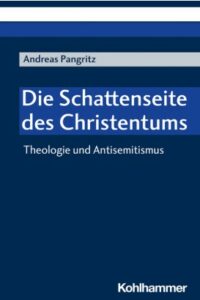 In the second chapter, Pangritz addresses the problematic distinction between the terms anti-Judaism and antisemitism. He shows that the distinction between a theologically-argued hostility towards Jews and a racially argued antisemitism, which has been repeatedly postulated since the end of the Second World War, has not stood the test of time. On the contrary, such a distinction harbors the danger that (Christian) hatred of Jews is trivialized by juxtaposing it with antisemitism. Pangritz proposes “not to speak of a break, but rather of a transformation of the traditional Christian ‘doctrine of contempt’ (Lehre der Verachtung) into the modern forms of antisemitism” (35). It remains unclear, however, why Pangritz returns to the concept of anti-Judaism later in the book (e.g. 119). The term has been overused by Christian apologetics, and Pangritz himself has pointed out that the academic distinction between anti-Judaism and antisemitism has not produced any new insights or meaningful differentiations. (30). Conceptual clarity would have been helpful here, especially since Pangritz argues well with Léon Poliakov, Peter Schäfer and even Reinhard Rürup that “antisemitism” should be used in its most general sense: “The word ‘antisemitism’ denotes hostility, hatred and contempt of all kinds against Jews and Judaism; this does not exclude differences in motivation, but includes them” (33). However, this small point is the only criticism I can make in the entire book.
In the second chapter, Pangritz addresses the problematic distinction between the terms anti-Judaism and antisemitism. He shows that the distinction between a theologically-argued hostility towards Jews and a racially argued antisemitism, which has been repeatedly postulated since the end of the Second World War, has not stood the test of time. On the contrary, such a distinction harbors the danger that (Christian) hatred of Jews is trivialized by juxtaposing it with antisemitism. Pangritz proposes “not to speak of a break, but rather of a transformation of the traditional Christian ‘doctrine of contempt’ (Lehre der Verachtung) into the modern forms of antisemitism” (35). It remains unclear, however, why Pangritz returns to the concept of anti-Judaism later in the book (e.g. 119). The term has been overused by Christian apologetics, and Pangritz himself has pointed out that the academic distinction between anti-Judaism and antisemitism has not produced any new insights or meaningful differentiations. (30). Conceptual clarity would have been helpful here, especially since Pangritz argues well with Léon Poliakov, Peter Schäfer and even Reinhard Rürup that “antisemitism” should be used in its most general sense: “The word ‘antisemitism’ denotes hostility, hatred and contempt of all kinds against Jews and Judaism; this does not exclude differences in motivation, but includes them” (33). However, this small point is the only criticism I can make in the entire book. But as Tim Lorentzen’s new book illustrates, it is hardly the first time that interpretations of Bonhoeffer have been based on his ties to the German resistance. Lorentzen, Professor of Early Modern Church History at Kiel University, traces the chronology of German cultural narratives about Bonhoeffer’s resistance, and their intersections with German Protestant memorialization, from 1945 to 2006. His focus on resistance (rather than German historiography about Nazism, the Holocaust, the Protestant Kirchenkampf, or Bonhoeffer’s theological writings) is a narrow lens through which to understand Bonhoeffer, but it raises interesting and provocative questions. As historians know, Bonhoeffer was a minor figure in the resistance circles—and yet this very aspect of his life has become central in the narratives about him. Would Bonhoeffer’s theology be as well-known and widely read today if this were not the case? Has the emphasis on resistance led to the historical distortions one finds in many works on Bonhoeffer? Conversely, does it offer insights we might not otherwise have into his theology and his life?
But as Tim Lorentzen’s new book illustrates, it is hardly the first time that interpretations of Bonhoeffer have been based on his ties to the German resistance. Lorentzen, Professor of Early Modern Church History at Kiel University, traces the chronology of German cultural narratives about Bonhoeffer’s resistance, and their intersections with German Protestant memorialization, from 1945 to 2006. His focus on resistance (rather than German historiography about Nazism, the Holocaust, the Protestant Kirchenkampf, or Bonhoeffer’s theological writings) is a narrow lens through which to understand Bonhoeffer, but it raises interesting and provocative questions. As historians know, Bonhoeffer was a minor figure in the resistance circles—and yet this very aspect of his life has become central in the narratives about him. Would Bonhoeffer’s theology be as well-known and widely read today if this were not the case? Has the emphasis on resistance led to the historical distortions one finds in many works on Bonhoeffer? Conversely, does it offer insights we might not otherwise have into his theology and his life?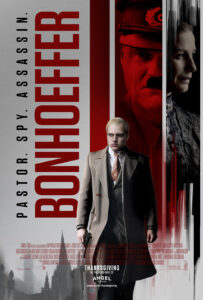 The film, which is beautifully shot and scored, but at times laden with clunky dialogue, begins with a glimpse into the domestic life of the Bonhoeffer family (warm and loving, and also tranquil until Dietrich’s beloved older brother Walter is killed in the Great War). Yet it largely focuses on Bonhoeffer’s involvement in a plot to assassinate Adolf Hitler, who became chancellor of Germany in 1933. The film flashes back and forth, from Bonhoeffer’s imprisonments in Buchenwald and Flossenbürg to the years preceding the war. It tells the tale of a young theologian whose participation in the 1944 plot to assassinate the Führer and overthrow the Nazi regime seems nearly inevitable. The flashbacks often muddle both the chronology and the film’s interpretation of Bonhoeffer’s de-contextualized words.
The film, which is beautifully shot and scored, but at times laden with clunky dialogue, begins with a glimpse into the domestic life of the Bonhoeffer family (warm and loving, and also tranquil until Dietrich’s beloved older brother Walter is killed in the Great War). Yet it largely focuses on Bonhoeffer’s involvement in a plot to assassinate Adolf Hitler, who became chancellor of Germany in 1933. The film flashes back and forth, from Bonhoeffer’s imprisonments in Buchenwald and Flossenbürg to the years preceding the war. It tells the tale of a young theologian whose participation in the 1944 plot to assassinate the Führer and overthrow the Nazi regime seems nearly inevitable. The flashbacks often muddle both the chronology and the film’s interpretation of Bonhoeffer’s de-contextualized words.
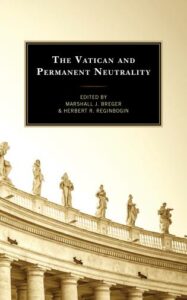 Breger rightly notes that following World War II, neutrality had a negative connotation and was often seen as a form of collaboration with the Nazis. Countries like Switzerland, and to some extent Sweden, did not emerge from the war with their reputations fully intact. Consequently, for many years, Vatican neutrality has received little attention in academic literature. This volume, which spans from 1870 to 2020, helps to close that gap by examining various aspects of the Vatican’s neutrality over these 150 years. However, the main focus is on the Vatican’s neutrality as defined in the Lateran Pacts of 1929, which also established the city-state. Breger states the goal of the project thus: “This book will consider the interplay between two normatively disparate subjects – the concept of neutrality in international law and the concept of the Vatican as a neutral actor in international relations” (Breger xii). This review will provide a general overview of the volume, highlighting a selection of the thirteen essays rather than examining each one in detail. I will focus primarily on essays that fall more closely in my own research purview, which deals with Fascism, WWII and the immediate postwar years.
Breger rightly notes that following World War II, neutrality had a negative connotation and was often seen as a form of collaboration with the Nazis. Countries like Switzerland, and to some extent Sweden, did not emerge from the war with their reputations fully intact. Consequently, for many years, Vatican neutrality has received little attention in academic literature. This volume, which spans from 1870 to 2020, helps to close that gap by examining various aspects of the Vatican’s neutrality over these 150 years. However, the main focus is on the Vatican’s neutrality as defined in the Lateran Pacts of 1929, which also established the city-state. Breger states the goal of the project thus: “This book will consider the interplay between two normatively disparate subjects – the concept of neutrality in international law and the concept of the Vatican as a neutral actor in international relations” (Breger xii). This review will provide a general overview of the volume, highlighting a selection of the thirteen essays rather than examining each one in detail. I will focus primarily on essays that fall more closely in my own research purview, which deals with Fascism, WWII and the immediate postwar years.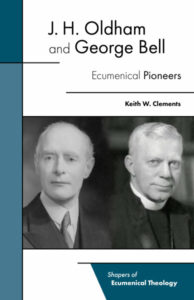 Christian internationalism has yet to find a secure place in the various histories of twentieth-century churches. Very largely this is due to a persistent emphasis on national categories and narratives, but denominational perspectives have also fashioned a great deal of what we expect to find in the foreground. All too often, Bell and Oldham may be observed, usually dutifully and briefly, hovering in the background of anything other than ecumenical surveys. In the final volume of the recent Oxford History of Anglicanism (OUP, 2019), Bell flits about here and there, but there is no very confident sense of where to put him for very long. Meanwhile, Oldham, the United Free Church layman, has almost vanished from ecclesiastical memory altogether. This is an authentic tragedy because it indicates how horizons have contracted across the western Protestant churches in the half-century since their deaths.
Christian internationalism has yet to find a secure place in the various histories of twentieth-century churches. Very largely this is due to a persistent emphasis on national categories and narratives, but denominational perspectives have also fashioned a great deal of what we expect to find in the foreground. All too often, Bell and Oldham may be observed, usually dutifully and briefly, hovering in the background of anything other than ecumenical surveys. In the final volume of the recent Oxford History of Anglicanism (OUP, 2019), Bell flits about here and there, but there is no very confident sense of where to put him for very long. Meanwhile, Oldham, the United Free Church layman, has almost vanished from ecclesiastical memory altogether. This is an authentic tragedy because it indicates how horizons have contracted across the western Protestant churches in the half-century since their deaths.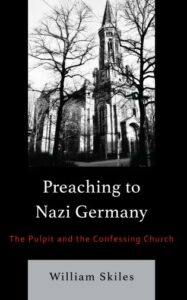 After setting his agenda in the introductory chapter, Skiles outlines in Chapter 2 the religious conflicts under National Socialism, and more specifically, the division in German Protestantism between the German Christian movement, which sought to align Protestant theology and praxis with Nazi ideology, and the Confessing Church. For Skiles, at the foundation of that conflict was “a profound disagreement about the nature of divine revelation,” (p. 28) with the German Christians claiming to find divine revelation in history, national identity, and racial “science.” By contrast, the Confessing Church, in the spirit of the Reformation, held to the doctrine that knowledge of God is to be found in scripture alone. This chapter provides important context as it guides the reader through some of the early milestones in the regime’s conflict with the Confessing Church: the controversy over the “Aryan Paragraph” of 1933, which excluded clergy of alleged Jewish heritage from the pastorate; the subsequent formation of the Pastors’ Emergency League, which formed the basis for the Confessing Church; and the issuing of the Barmen Declaration in 1934. Skiles also effectively challenges in this chapter two common and simplified interpretations: that the Confessing Church was an anti-Nazi resistance group, and that the Confessing Church’s conflict with the regime was essentially about ecclesiastical freedom.
After setting his agenda in the introductory chapter, Skiles outlines in Chapter 2 the religious conflicts under National Socialism, and more specifically, the division in German Protestantism between the German Christian movement, which sought to align Protestant theology and praxis with Nazi ideology, and the Confessing Church. For Skiles, at the foundation of that conflict was “a profound disagreement about the nature of divine revelation,” (p. 28) with the German Christians claiming to find divine revelation in history, national identity, and racial “science.” By contrast, the Confessing Church, in the spirit of the Reformation, held to the doctrine that knowledge of God is to be found in scripture alone. This chapter provides important context as it guides the reader through some of the early milestones in the regime’s conflict with the Confessing Church: the controversy over the “Aryan Paragraph” of 1933, which excluded clergy of alleged Jewish heritage from the pastorate; the subsequent formation of the Pastors’ Emergency League, which formed the basis for the Confessing Church; and the issuing of the Barmen Declaration in 1934. Skiles also effectively challenges in this chapter two common and simplified interpretations: that the Confessing Church was an anti-Nazi resistance group, and that the Confessing Church’s conflict with the regime was essentially about ecclesiastical freedom.